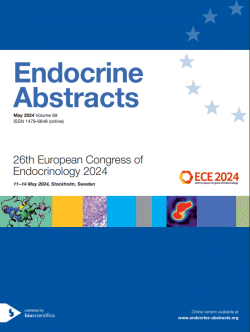
26th European Congress of Endocrinology
Stockholm,
Sweden
11 May 2024 - 14 May 2024

Rapid Communications
Rapid Communications 1: Reproductive and Developmental Endocrinology
ea0099rc1.1 | Rapid Communications 1: Reproductive and Developmental Endocrinology | ECE2024
Comparative study of the legal framework for the medical care of people with differences of sex developmental (DSD) across the world
Kalfa Nicolas , Drzewiecki Beth , Braga Luis , Castagnetti Marco , Birraux Jacques , Fossum Magdalena , Springer Alexander , Nieuwhof-Leppink Anka , Lopez PJ , Cherian Abraham , Hoebeke Piet , Vialla Clementine , Paris Francoise , Vialla Francois
ea0099rc1.2 | Rapid Communications 1: Reproductive and Developmental Endocrinology | ECE2024
Endometrial transcriptome alterations following short-term liraglutide treatment in infertile women with polycystic ovary syndrome and obesity
Jensterle Mojca , Salamun Vesna , Vrtacnik Bokal Eda , Lovrecic Luca , Maver Ales , Peterlin Borut , Herman Rok , Janez Andrej
ea0099rc1.3 | Rapid Communications 1: Reproductive and Developmental Endocrinology | ECE2024
Clinical and genetic characterization of a large cohort of patients with premature ovarian failure
Federici Silvia , Messetti Dario , Rossetti Raffaella , Moleri Silvia , Persani Luca , Bonomi Marco
ea0099rc1.4 | Rapid Communications 1: Reproductive and Developmental Endocrinology | ECE2024
The role of rare human PROK2/R2 mutations in the reproductive and metabolic health of the general population: A recall-by-genotype study
Stamou Maria , Chiu Crystal , Jadhav Shreya V. , Salnikov Kathryn B. , Plummer Lacey , Seminara Stephanie B. , Balasubramanian Ravikumar
ea0099rc1.5 | Rapid Communications 1: Reproductive and Developmental Endocrinology | ECE2024
Characterization of the role of LEAP-2 in the metabolic control of puberty
Torres Granados Carmen , Ruiz-Cruz Miguel , Guerrero Ruiz Yolanda , Uceda Rodriguez Esperanza , Rodriguez Vazquez Elvira , Aranda Torrecillas Alvaro , Tena-Sempere Manuel , Roa-Rivas Juan
ea0099rc1.6 | Rapid Communications 1: Reproductive and Developmental Endocrinology | ECE2024
The prevalence of serious autoimmune diseases is increased in women with premature ovarian insufficiency in Finland – A population-based study
Savukoski Susanna , Silven Heidi , Pesonen Paula , Pukkala Eero , Gissler Mika , Suvanto Eila , Ollila Meri-Maija , Niinimaki Maarit
ea0099rc1.7 | Rapid Communications 1: Reproductive and Developmental Endocrinology | ECE2024
Characterisation of the daily rhythm of salivary androgens in healthy women and in women with polycystic ovary syndrome by liquid chromatography-tandem mass spectrometry
Rotolo Laura , Gambineri Alessandra , Bissi Valentina , Zauli Francesca , Galante Greta , Cecchetti Carolina , Dionese Paola , Belardinelli Elisabetta , Solmi Beatrice , Pagotto Uberto , Fanelli Flaminia



